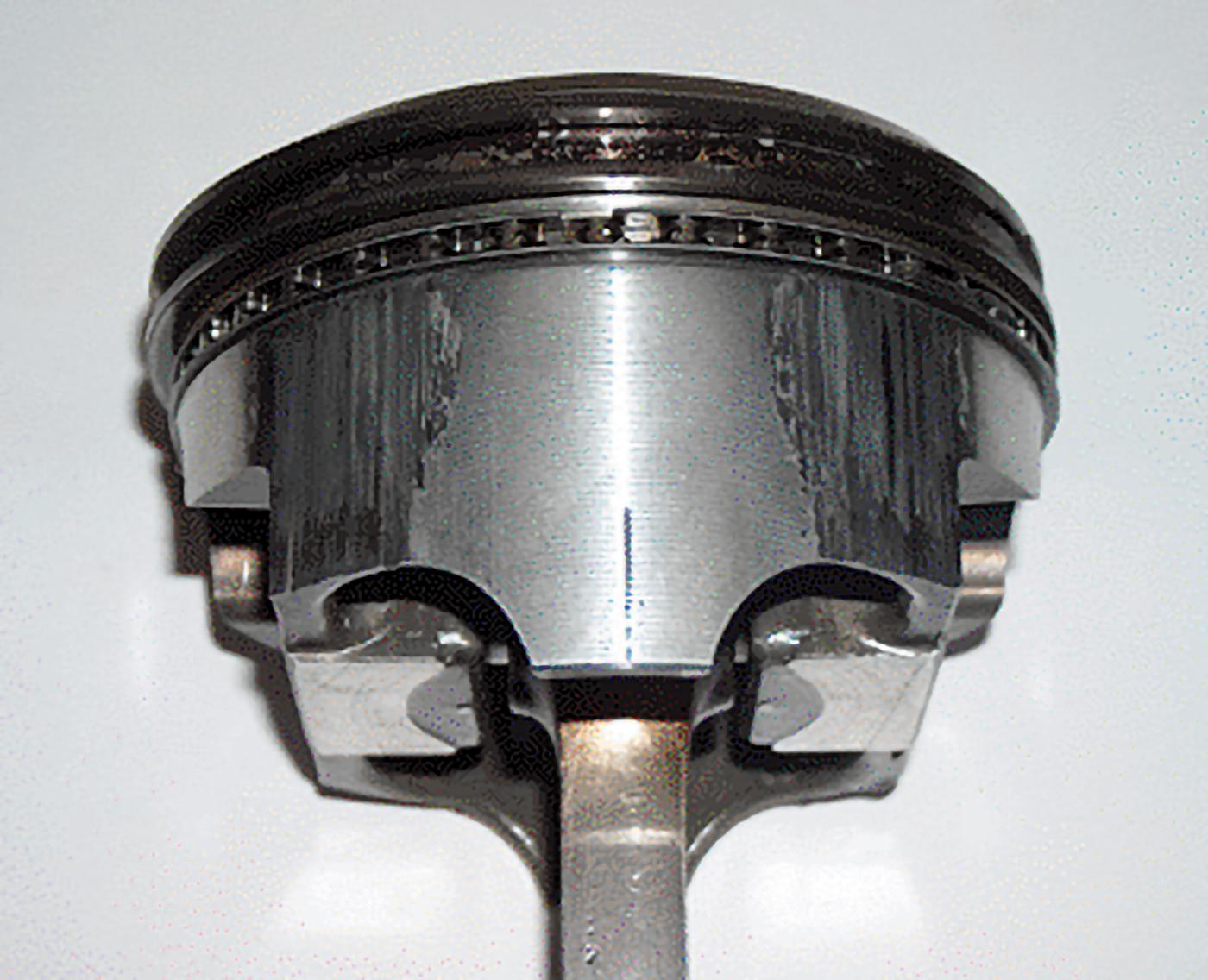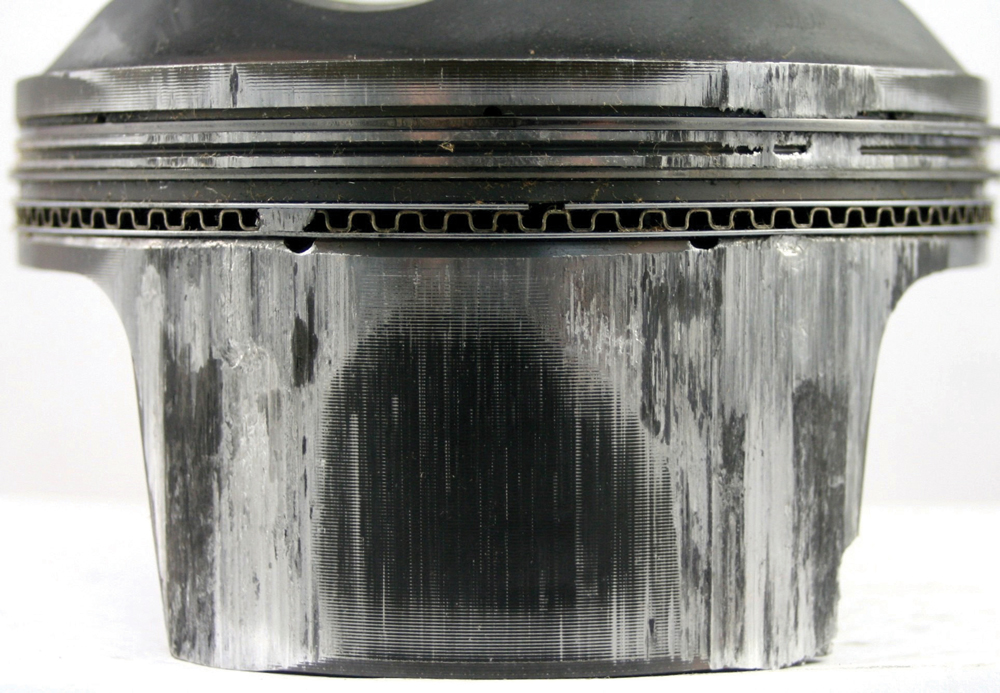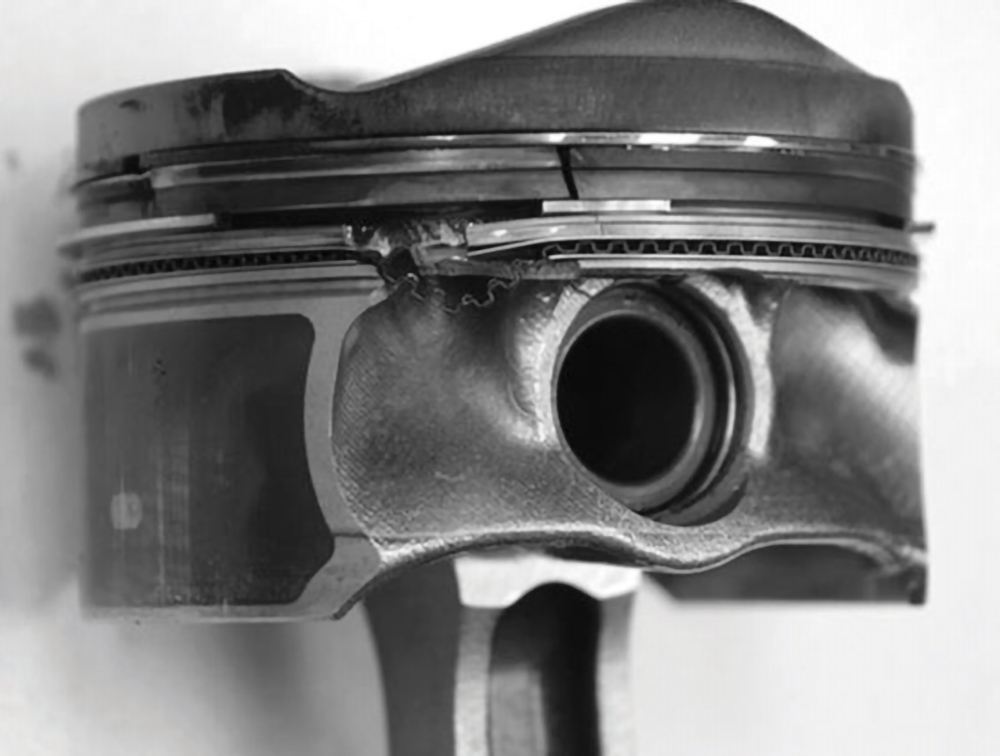PRI Education: Reading The Unspoken Language Of Broken Parts

The most common piston failure in a newly installed engine is typically defined as four corner scuffing, which is seen here.
Engine builders often need to hone their “detective” skills to properly determine the cause of failures.
I was a group leader of teams doing engine failure analysis at a time when forensic criminology shows were very popular. I used to tell members that the difference between an engine builder and the police force is that police usually have a crime scene. We, as engine builders, usually get a broken engine that has been trucked back to us. Because of that, we typically have no opportunity to investigate the crime scene to evaluate the cooling system, the ignition system, the tune, the chassis, what have you.
That means being successful at failure analysis requires an exercise of prudence and wisdom. The qualities of having experience, knowledge, and sound judgment are paramount. The skills learned in failure analysis will impact how you look at everything in an engine from beginning to end. Although, we often perform failure analysis without realizing that we are practicing analytics. For example, engine builders know to observe the environment and hazards before pulling that wrench to loosen a bolt, probably because we have smashed a finger by doing that in the past. This is a learned behavior because we had a failure that taught us that environmental hazards plus pulling a wrench resulted in a smashed finger, so we adjust our process going forward.
We at the AERA Engine Builders Association (AERA), are often asked to evaluate failures of engines, parts, and pieces during a phone call. Today, we can get images thanks to cell phones, but that is a pretty recent change. Before, it was often deducing what someone was trying to convey by drawing a mental image based on failures that we had been exposed to at some point. For that reason, and because you can’t always get “the whole picture” in photos alone, AERA created the Engine Component Failure Analysis Manual for association members. The manual is a combined effort of many expert engine machinists, engine parts manufacturers, and technical advisors in the engine repair industry.
Let’s Talk About Pistons
The most common part that AERA receives questions about is pistons. It’s no secret that the piston shares a great deal of information about the engine’s health. However, the ability to read its signs is key to resolving problems and protecting your shop and the end user from future failures. Sometimes the changes are out of your control, but if you can educate the end user, you might influence changes that alleviate the failure.

The two most common piston failures in a newly installed engine are four corner scuffing or skirt seizure due to overheating. In either case, the engine rebuilder usually gets a complaint that they did not provide enough piston-to-wall clearance, but that’s not always correct, as shown by the following points.
Reasons Behind Four Corner Scuffing
Indications of very high operating temperatures can include:
• Heavy loading of the engine before reaching normal operating temperatures
• Coolant system defects cause a stuck thermostat
• Adding coolant to a hot engine, mainly upon initial start-up
• Non-lubricated wrist pin upon initial assembly
• Engine overheating from abnormal combustion
• Insufficient wrist pin clearance
• Improper air bleeding of the cooling system—use vacuum coolant fill methods
Evidence of Skirt Seizure Due to Overheating
• Severe scuffing on the piston skirt
• Deep gouges on the skirts where the material is pulled out and transferred to the cylinder walls
• As damage progresses, scuffing can be transferred up into the ring lands
• Contact may be heaviest over the skirt struts due to uneven expansion of the piston
Some root causes of skirt seizure due to overheating include an excessively high engine operating temperature for an extended period of time; a cooling system failure because the system was not completely filled; or there was a thermostat malfunction, faulty water pump, cooling fan malfunction, belt slip or break, or related failures; or an oil film breakdown due to high engine cooling temperatures.
What Is Low Speed Pre-Ignition?
A more recent phenomenon in the world of engine failures is the return of pre-ignition failures. Pre-ignition failures were not completely gone, but the engine management systems have drastically reduced the frequency and breadth of failures. Now that we have many manufacturers building Gas Direct Injected (GDI) engines, there has been an uptick in the failures defined as pre-ignition.
Low Speed Pre-Ignition (LSPI) will take place when the temperature triggers an ignition of volatile chemicals within the combustion chamber. The most likely cause for an LSPI failure is using an incorrect additive blend for the engine type. In these instances, it is advised that the builder reviews the certification label on the bottle of oil or consults the dealer service.

As stated earlier, AERA has a Failure Analysis Manual with 240 pages of engine component failure examples focused on the cause-and-effect relationships. In addition, there are pictures, definitions, technical data, the nomenclature of components, and a list of contributors.
If you keep having engine components fail, or if you find the topic interesting and want to ensure your shop’s reputation, take advantage of the Failure Analysis seminar at the 2022 Performance Racing Industry (PRI) Trade Show. There will be a panel of experts representing piston design, bearing design, valvetrain, balancing, and more. You can even bring some parts that you have in question, and we can all learn and share together. See you there!
Chuck Lynch is the Director of Technical Services for the AERA Engine Builders Association based in Cary, Illinois. Lynch is well known in the engine rebuilding community and holds vast knowledge of the industry and the rebuilding process, having prior experience with Jasper Engines & Transmissions, Rottler Manufacturing, MAHLE, and the US Marine Corps.
 MEMBERSHIP LOGIN
MEMBERSHIP LOGIN JOIN PRI
JOIN PRI


